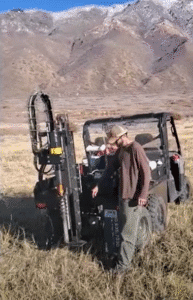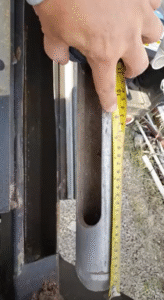Description
There are several types of seedling/plug planters: Spindle Transplanter, Dryland Plug Planter, These planters are designed to automatically plant containerized nursery stock and can handle seedlings up to 60 cm long.
The Dryland Plug Planter is a trailer unit towed behind a tractor. It is a combination of a leveling device, hydraulic auger with a scarifier, rotating carousel mounted on a movable carriage and two packing spades. the platform is leveled with hydraulic cylinders. The auger digs a hole; the scarifier auger then removes any competing vegetation from around the hole. The carousel containing the seedlings rotates and the carriage moves forward on the platform, dropping a seedling into the hole. The packing spades firm the soil around the seedling. Planting rate is estimated at more than one per minute. Specifications: carousel capacity: 24 seedlings, auger diameter: 7.6-12.7 cm, scarifier: 46 cm, depth: 61-76 cm, power requirements: 52 to 75 kW for drawbar.
The power harrow is a tillage implement similar to a tiller that is used to cultivate and prepare a seedbed. It can be mounted on either a 3-point tractor or a skid steer. Instead of the tines being horizontal like a traditional tiller, the tines are vertical, which improves penetration and reduces the chances of subsurface compaction. Power harrows can be fitted with a packer wheel that helps firm the planting bed. It can be fitted with different sizes of dibblers to create multiple holes at a time to plant seedlings into. It is more efficient than augers and hand dibbling.
Application
The machines plant stock quickly and effectively. Leveling devices and high clearance enable operation on rough ground or moderate slopes, while insuring adequate placement. Auger holes allow for sufficient moisture uptake and unrestricted root growth for better survival.
Considerations:
- The power harrow can be used in soils with more rock and debris than a standard tiller, but it cannot be used in rocky or cobbly soils.
- Power harrow is fairly slow compared to other ground preparation tools and not appropriate for large-scale projects.
- Transplanters require ideal soil conditions (not too dry or wet) for proper planting and machine operation. When soil is dry, penetration is limited and holes collapse. Soil with too much rock can damage the equipment.
- Operator training is crucial for transplanter use so that dibblers enter and exit the holes fully and as straight as possible before moving the
tractor and allowing the machine to go at its speed and not forcing it to go faster.
References / Additional Information
Hallman, R. 1981. BLM’s equipment development for revegetating disturbed lands. VREW 35th Annual Report. 1981 February 8-9. Tulsa, OK: 41.
Jensen, S. 2023. Designing the target plant and a wildland transplanter for rapid plant-based sagebrush restoration. SRM Meeting. 2023 February 12-16. Boise, ID.
Spink, L. 1979. Steep-slope stabilization. VREW 33rd Annual Report. 1979 February 11-12. Casper, WY: 12.
Summers, D. 2024. Novel equipment for landscape scale restoration. SRM Meeting. 2024 January 28-February 1. Sparks, NV.



